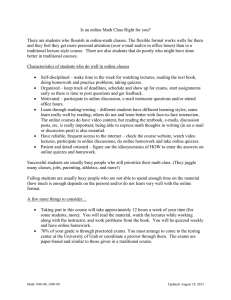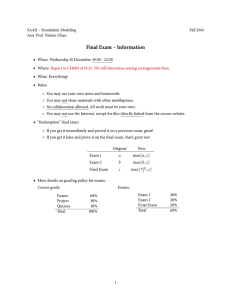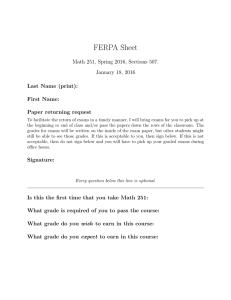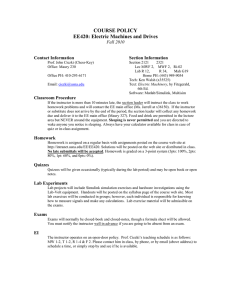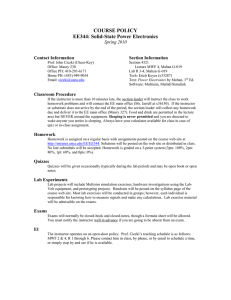THE UNIVERSITY OF NORTH CAROLINA AT GREENSBORO
advertisement
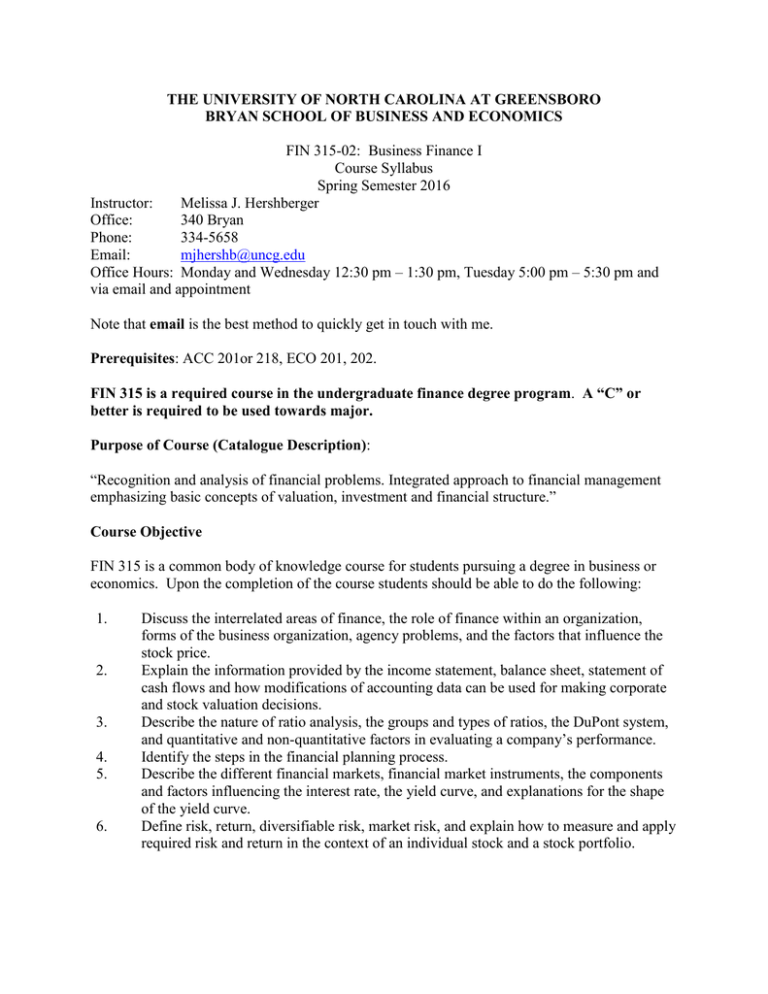
THE UNIVERSITY OF NORTH CAROLINA AT GREENSBORO BRYAN SCHOOL OF BUSINESS AND ECONOMICS FIN 315-02: Business Finance I Course Syllabus Spring Semester 2016 Instructor: Melissa J. Hershberger Office: 340 Bryan Phone: 334-5658 Email: mjhershb@uncg.edu Office Hours: Monday and Wednesday 12:30 pm – 1:30 pm, Tuesday 5:00 pm – 5:30 pm and via email and appointment Note that email is the best method to quickly get in touch with me. Prerequisites: ACC 201or 218, ECO 201, 202. FIN 315 is a required course in the undergraduate finance degree program. A “C” or better is required to be used towards major. Purpose of Course (Catalogue Description): “Recognition and analysis of financial problems. Integrated approach to financial management emphasizing basic concepts of valuation, investment and financial structure.” Course Objective FIN 315 is a common body of knowledge course for students pursuing a degree in business or economics. Upon the completion of the course students should be able to do the following: 1. 2. 3. 4. 5. 6. Discuss the interrelated areas of finance, the role of finance within an organization, forms of the business organization, agency problems, and the factors that influence the stock price. Explain the information provided by the income statement, balance sheet, statement of cash flows and how modifications of accounting data can be used for making corporate and stock valuation decisions. Describe the nature of ratio analysis, the groups and types of ratios, the DuPont system, and quantitative and non-quantitative factors in evaluating a company’s performance. Identify the steps in the financial planning process. Describe the different financial markets, financial market instruments, the components and factors influencing the interest rate, the yield curve, and explanations for the shape of the yield curve. Define risk, return, diversifiable risk, market risk, and explain how to measure and apply required risk and return in the context of an individual stock and a stock portfolio. 7. 8. 9. 10. 11. Demonstrate how to find the present and future values of lump sums and annuities, solve for the time or interest rate in TVM problems, calculate periodic and effective interest rates, and construct a loan amortization schedule. List the main classifications and characteristics of bond, calculate bond price and various bond yields, and explain the importance of bond ratings and criteria for rating bonds. Identify important stock ownership rights and terms, how to value common and preferred stock, and understand stock market information in the newspaper and market efficiency. Explain the concept of a firm’s weighted average cost of capital, define and calculate the component costs of capital using alternative approaches, calculate the weighted average cost of capital, and identify situations when the use of the composite WACC is not appropriate. Explain capital budgeting and steps in the capital budgeting project, methods to evaluate project financial viability, NPV profiles, the problem of multiple IRRs. FIN 315 and Core Business Learning Goals The Bryan School of Business and Economics’ Mission Statement In the Bryan School of Business and Economics, we create and disseminate knowledge about the theory and practice of business. In addition to our courses and research, we accomplish this through hands-on projects, global experiences, and outreach to the community. Our work produces principled leaders and exceptional problem solvers who have a global perspective, an innovative mindset, a broad understanding of sustainability, and a commitment to improve the organizations in which they work and the communities in which they live. Student Learning Goals Each program within the Bryan school has separate learning goals as listed with the degree program. The essential components of a professional education in business (excluding the B.S. and B.A. in Economics, the B.S. in Consumer, Apparel, and Retail Studies and the B.A. in Sustainable Tourism and Hospitality) include common courses for breadth and opportunities for advanced work for depth in the various business disciplines. These core business programs share the following common learning goals: 1. Students will implement the various steps of the critical thinking process, supported by the appropriate use of analytical and quantitative techniques, to formulate recommendations for subsequent decision making. 2. Students will apply appropriate ethical standards when making recommendations for business decision making. 3. Students will evaluate business decisions in the context of sustainability goals, balancing environmental, social, and economic needs, conditions, and potential decision impacts. 4. Students will formulate appropriate strategies, in the context of global issues and forces, to improve business performance in the world economy. 5. Students will explain the roles of innovation and innovation management in achieving successful business strategies, decisions, and performance. 6. Students will be able to plan, schedule, contribute to, and lead projects. Impact of this Course on the Program Student Learning Goals Upon successful completion of Business Finance I (FIN 315), students will meet various components of the Critical Decision-Making (#1) Student Learning Goals. Additionally, students will be exposed to elements of financial global issues supporting Student Learning Goal #4. Assessment of Program Student Learning Goals in FIN 315 – Spring Semester 2016 To support AACSB accreditation and professional education in business, student learning goal #2 (Ethics) will be assessed in this course this semester. Students will apply appropriate ethical standards when making recommendations for business decision making. Required Text: Lawrence J. Gitman, Principles of Managerial Finance, Brief Seventh Edition. Pearson Publishing. 2014. You Have Three Options: 1. The Hard Copy of the Full Text (New or Used) ISBN: 9780133546408 2. The E-Text Available Through the Pearson Website ISBN: 9780133547238 3. The Unbound Copy available through Pearson or other sources: 9780133547221 Please note, I will not being using the Pearson MyFinanceLab as a part of this class. Financial Calculator: The recommended calculator for this course is the HP 10B II +. Any calculator that is capable of performing time value of money, amortization, net present value and internal rate of return calculations will be sufficient. However, the notes for this class are designed for the HB 10B II + and financial calculations will be taught with this calculator only. You are responsible for learning the keystrokes of any other calculator. You may not share a calculator during exams, tests or quizzes. Grading Course grades will be determined as follows: Quizzes Exams (3 @ 20% each) Cumulative Final Exam 10% 60% 30% The grading scale is as follows for undergraduate students: *A A- 92% and above 90 – 91.99% 88 – 89.99% 82 -87.99% 80 – 81.99% 78 – 79.99% 72 – 77.99% 70 – 71.99% 68 – 69.99% 62 - 67.99% 60 – 61.99% < 60% B+ B BC+ C CD+ D DF *Note: A grade of “A+” will be given if a student has a final average grade of 98.0% or higher AND each individually graded item is of “A” (92.0% or higher) quality. Grading – Graduate Students ONLY If you are a graduate student taking FIN 315, then you are subject to the grading scale below: A AB+ B BC+ C F 92% and above 90 – 91.99% 88 – 89.99% 82 -87.99% 80 – 81.99% 78 – 79.99% 70 – 77.99% 69.99 % - 0% Class Organization, Procedures and Expectations It is no secret that Finance 315 is a difficult and TIME CONSUMING class for most students. To do well, you must keep up with the material and assignments. It is a subject that most students must study regularly instead of waiting until the last minute to “cram”. Students who do not keep up with the class usually have the most difficulty with FIN 315. Therefore, I have the following expectations of you: Read the assigned book material before the lecture Work all assigned problems before class Bring textbook, notebook, pencil and calculator to each class. Devote at least six to nine hours a week outside of class for studying See me as soon as you encounter difficulties Have a positive attitude about learning and be respectful of others Be on time for class and have good attendance In return, I pledge to: Be on time and prepared for class Be organized in my lectures as well as in the general conduct management of the class Provide you with information in advance so you can schedule your work Clearly explain concepts and problems Treat you fairly with respect to exams, grading, etc Be respectful of you and to have a good attitude Provide timely feedback on assignments and exams For further Faculty and Student Guidelines, please see: http://bae.uncg.edu/assets/faculty_student_guidelines.pdf A large portion of class time is devoted to lecture, and class sizes are not small in FIN 315. Therefore, individual study and preparation outside of class are extremely important to your success. Please read the material and work problems before coming to class. Homework and Practice Problems: No homework will be collected or graded. You are expected to complete the practice problems assigned for each chapter. The assigned problems from the textbook are listed in this syllabus. The solutions are posted in Canvas in Modules. Additional practice problems and old exam are posted to Modules in Canvas. Video solutions to these practice problems are posted separately. You are expected to work the problems individually prior to viewing the solution tutorial. Finally, practice multiple choice questions are posted in Canvas. Solutions to these multiple choice problems are posted separately. Course Grading and Evaluation Your final grade that you will receive in this class depends upon your grades on a cumulative final exam, three exams, and short pen and paper quizzes. Adherence to the Academic Integrity Policy is expected and required of all students for all exams and assignments. Failure to abide by this policy will result in disciplinary action. Details of the Academic Integrity Policy are available at http://saf.dept.uncg.edu/studiscp/Manual.html. Exams: There will be four exams: three during the semester and one cumulative final exam. The exam schedule is as follows: Exam 1 Exam 2 Exam 3 February 10, 2016 March 16, 2016 April 13, 2016 Final Exam: Wednesday, May 4, 2016 (7:00 pm–10:00 pm) The general format of these exams will be multiple-choice questions. All exams will begin on time. You will not be allowed to sit for any exam if you are late to class. Exams 1, 2, 3 will begin at 6 pm and you will have exactly one hour and fifteen minutes to complete. The final exam will begin exactly at 7 pm and you will have three hours to complete. The instructor reserves the right to deny a student to sit for any test or exam in the event that the student is late for the start of the test or exam. Although most of the question on the mid-session exams will come directly from chapters assigned since the last exam, some questions may be taken from earlier chapters as they relate to the current chapter material; in that sense, all exams are cumulative. The final exam for this class is Wednesday, May 4, 2016 beginning at 7:00 pm and ending at 10:00 pm. You MUST plan now for this exam. The University requires that all students adhere to the University exam schedule. There is no exception to this policy. Do not schedule your return home for winter break prior to completion of our exam– doing such is not an excuse for missing or rescheduling the final exam in this class. The final exam is cumulative. The final exam will be in a multiple choice format and you will have the entire exam period (3 hours) to complete it. Students with more than two examinations within 24 hours may apply to the University Registrar’s Office for permission to change their exam schedule. The exam that is changed is not at the instructor’s discretion. The Registrar’s Office deadline is by 5:00 pm, April 26, 2016. You must deliver the Registrar’s signed request to change your exam to me no later than 6:00 pm on April 26, 2016. The date of the exam in this class for a University approved exam change will be April 28, 2016 beginning at 8:00 am and ending at 11:00 am. The place for this exam will be given to you at the time you turn in your paper work. There are no makeup exams. If you have prior permission from the instructor, the weight attributable to a missed exam will be allocated to the final exam. Unless you have received special permission from me, you are not permitted to take an exam in one of my other classes. Please try to notify me at least 48 hours prior to the exam. Failure to notify me within 24 hours after the scheduled exam will result in an F grade (quiz score of zero). At the time of notification, I will determine whether to consider the absence excused or unexcused and follow University policy. In the event you miss an exam for medical or psychological circumstances, you must provide me with written verification. Quizzes: There will be a minimum of three short graded quizzes. These quizzes will be graded for accuracy. The quizzes will be given at the beginning of class. Graded quizzes will be announced in class. One quiz score is dropped. The dropping of one quiz score is in place to accommodate any reason for missing a quiz. There are no makeup quizzes. Attendance Policy: Attendance will not be taken in this class. You are expected to come to class on time and stay for the entire period. It is extremely disruptive to the educational environment of the classroom when students come in late or leave early. This type of behavior will not be tolerated. If you have an emergency and need to leave early please tell the instructor at the beginning of class and accommodations will be made. Communication and Use of Canvas for this Course: Canvas is utilized for this course. You are responsible for any and all announcements posted in Canvas for this course. You are expected to check your posted grade with the grade you receive on returned papers/quizzes/tests in a timely manner. Electronic Devices in the Classroom: Unless you have permission from the instructor ELECTRONIC DEVISES (cellphones, smartphones, tablets, PDAs, Blackberries, iPods, MP3 players, recording devises, or any other electronic devise by any other name) WILL NOT BE ALLOWED IN THE CLASSROOM at anytime. You are not allowed to record the lectures given in this class. You are required to place all such devises in the “OFF” position and place them among your personal belongings. Any devise being seen or heard during the class period will be picked up by the instructor on the spot and returned at the end of class. Any such devise in the “ON” position during a test, quiz or exam will result in a grade of zero. The devise will be taken by the instructor and maybe picked up from the instructor’s office at a time prearranged by the instructor. Computers in the Classroom: The use of a personal laptop computer or tablet is allowed for the taking of notes during class lectures. The use of a personal laptop computer or tablet is not allowed for tests, quizzes or exams. The use of a personal laptop computer for any other purpose is strictly prohibited and may result in the student being removed from the classroom. Weather Policy: In the event of an adverse weather event (ice, snow, hurricane), this class will strictly follow the University schedule. The University posts on the web site the status of classes (additionally, the area TV stations make announcement) when a weather event occurs, please refer to this source prior to class time. Student Disabilities: All students with a disability requesting special services must go through the Office of Disabilities Services. If you are requesting special accommodations, please bring your paper work from Disability Services directly to me the first week of class. All such information will be held in confidence. The web link to this office is http://ods.dept.uncg.edu/services/ . Other Comments: There are no opportunities for extra credit in this course. The material in this course may be difficult for some. However, it is vital to your professional success. If you are having problems understanding the subjects presented, see me when you first encounter problems. Since this course builds on cumulative knowledge, problems in the early portion of the class will only compound as the semester progresses. IMPORTANT DATES Exam 1 Exam 2 Exam 3 February 10, 2016 March 16, 2016 April 13, 2016 Final Exam: Wednesday, May 4, 2016 (7:00 pm–10:00 pm) TENTATIVE SCHEDULE DATE January 13 TOPIC Introduction/Chapter 1 Chapter 1 & 2 January 20 Chapter 2 &3 January 27 February 3 February 10 February 17 Chapter 3 & 4 Chapter 4 & Review for Exam #1 EXAM #1 Chapter 5 February 24 Chapter 5& 6 March 2 March 16 March 23 Chapter 6 & Review for Exam 2 EXAM #2 Chapter 7 March 30 Chapter 7 &8 April 6 Chapter 9 & Review for Exam 3 April 13 April 20 EXAM #3 Chapter 10 ASSIGNMENT Read Chapter 1 Chapter 1 Required Problems:P1-1, P1-2, P1-3, and P1-4 Chapter 2 Required Problems: P2-1, P2-2, P2-4, and P2-5. Chapter 3 Required Problems: P3-1, P3-2, P34, P3-6, P3-10, P3-12, P3-13, P3-15, P3-18,P3-21, P3-23 and P3-25 Limit reading to sections 4.1 and 4.2 Chapter 4 Required Problems: P4-1, P4-2, P4-5 and P4-6 Chapter 5 Required Problems: P5-1, P5-2, P5-4, P5-8, P5-9, P5-10, P5-11, P5-15, P5-18, P5-19, P5-20, P5-29, P5-32, P5-35, P5-37, P5-47, P5-48 and P5-58 Chapter 6 Required Problems:P6-4, P6-9, P6-10, P6-11, P6-15, P6-20, P6-21, P6-23, P6-24 and P6-25 Chapter 7 Required Problems: P7-2, P7-6, P7-8, P7-9, P7-11, P7-13, P716, and P7-19 Chapter 8 Required Problems: P8-1, P8-5, P8-8, P8-11, P8-18, P8-21, P823, P8-24, and P8-26 Chapter 9 Required Problems: P9-3, P9-7, P9-9, P9-10, P9-12, P9-14, and P9-17 Chapter 10 Required Problems: P10- 1, P10-5, P10-6, P10-14, P10-18, and P10-21 May 4 FINAL EXAM 7:00 pm – 10:00pm NOTE: The above is a tentative schedule. We will cover all of the material in the schedule, but adjustments may be made as to date a topic is covered and quiz is given. The exam dates will not change. In the event that we speed up or slow down a bit, I will adjust the material on the exam, not the date of the exam. I will make an announcement in the class prior to a quiz.

